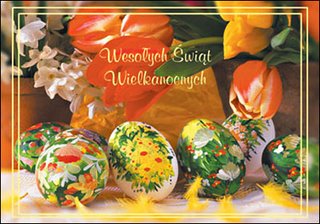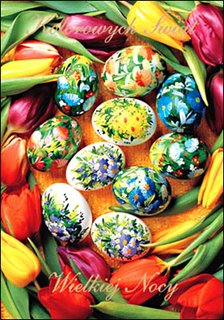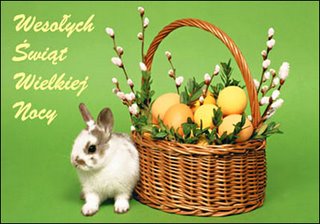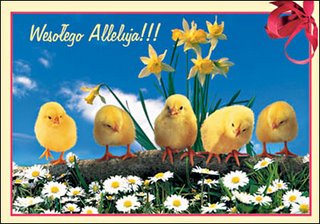Polish Easter:)

Helo everyone:)
Today - before putting some pictures of India I would like to describe you how Polish people celebrate Easter.
I know it MAY BE boring for you. But truly speaking it can be very intersting if you TRY HARDER!!!:)))) I am sure.:)))))
Some words are put in bold to make them more visible - these words are KEY-WORDS:)
Some sentences are put in itallic - these are the things I have never ever herad before finding this description of Polish Easter. Where am I living in? "You live - you learn" - how some singers would put it:)
Ok. That's all by now:) Nice reading:)
India - soon:)
Traditional Easter celebrations in Poland are as old and elaborate as Christmas celebrations and they involve a lot of preparations.One week before Palm Sunday, housewives stopped baking bread through the fear that the bread they baked throughout the rest of the year would spoil. Not until the Holy Week did they start baking. In some parts they began to do so on Good Friday, in others- it was not permitted to bake anything at all that day. If any housewife violated this ban, the entire village would be in danger of a long drought, which could be repelled only by throwing the pots and guilty housewife into a pond.
The celebration of Easter is preceded by Holy Week, which begins with Palm Sunday. Palm branches and twigs are indispensable accessories of the events of this day. They commemorate Christ’s triumphant entry into Jerusalem. After the festivities, palm leaves were used for magic rites, such as conjuring up storms and consecrating women at childbirth and sick domestic animals. The original palm branch is replaced by a willow or raspberry branch, and is decorated with ribbons, flowers, and leaves. It is believed that swallowing a willow catkin from a branch consecrated by a priest would bring health, and palm branch placed behind a holy image until the following year would bring the inhabitants luck.
The church bells that had resounded from Palm Sunday onwards fell silent on Holy Thursday. Rattles and clappers took their place. Fires were lit at crossroads so that wayfarers and poor people could warm themselves. Meals were also placed at these spots so that these people could nourish themselves – and together with them the good spirits of the house. On the morning of Holy Thursday, the vestments are changed on the miraculous icon in the chapel of the Pauline monastery at Jasna Gora in Czestochowa. This is one of the most important sites of the religious cult of the Poles, and has been venerated as a national shrine since 14 th century.
The next, Good Friday, marks the start of the vigil at symbolic tombs of Christ, which lasts until Holy Saturday. Visits are made to “tombs of Christ’. The adoration of the Good Friday tombs is called “the visitation of the tombs’. No animals could be slaughtered or bread baked, and mirrors covered over. The use of combs was not allowed, so Good Friday was a day of mourning. A special kind of bread was prepared for Easter Sunday, called “paska” . It was made of flour and yeast. The surface was spread with fat and decorated with a cross made of dough. Apart from cross of dough, it was decorated with flowers and birds. The tradition of preparing “paska” involved women. The master of the house was not permitted to take part of preparing the “paska”, otherwise his moustache would go grey and the dough would fail. On that day a “funeral of zur and herring” was organized. A clay pot with zur was shattered and a herring was hung on a branch as punishment “that for six weeks it had ruled over meat”.
On the next day, Holy Saturday, services accompanied by processions are held to commemorate the Resurrection. Inside the churches, priests sprinkled holy water on small baskets brought by believers and filled with “paska”, cakes, eggs, horseradish, sausages, ham, salt, pepper, and tiny sugar lambs. The consecration of eggs refers to egg being an ancient symbol of life. The consecration of horseradish refers to the bitterness of the passion of Jesus which, on the day of resurrection, changed into joy and sweetness. The custom of coloring eggs for Easter is still observed. Eggs which are painted in one color are called “malowanki” or “kraszanki”. If patterns are etched with a pointed instrument on top of the paint, the eggs are then called “skrobanki” or “rysowanki”. Those eggs decorated with the use of treated wax are called “pisanki”. Another technique involved gluing colored paper or shiny fabric on them. In old Poland, this resurrection service was an opportunity to identify witches, for witches were believed to enjoy eating sausage during sermons, still during Lent. It was also believed that a priest could see which of the women attending mass was a witch, but was not allowed to reveal his information. It was also believed that during Easter procession, a female collaborator of Satan was unable to go around the church three times, and had to leave the procession after the second circuit. After resurrection, gunshots were fired as an expression of joy.
On Sunday morning, beautifully laid table is covered with colored eggs, cold meats, coils of sausages, ham, yeast cakes, pound cakes, poppy-seed cakes, and in the middle of it all, a lamb made of sugar, commemorating the resurrected Christ. No smoke was permitted; therefore no warm meals were served. Horseradish was mixed with beets, “cwikla”, traditionally present on polish Easter tables. Sharing a boiled egg with one’s relatives is a national tradition. A piece of egg with salt and pepper, consecrated by priest, is an inseparable accessory in the good wishes we extend to each other at Easter. Each member of the household received also a piece of the consecrated bread. When spread with horseradish, it was supposed to give protection against throat diseases and against illnesses and complaints. Cakes were very important ingredients of Easter breakfast: gigantic cakes called “baby”, as well as “mazurki” were prepared only for those occasion. The “baby” were either plain vanilla, steamed, saffron-flavored, grated with egg yolk, almond flavored, layered, chocolate-flavored, fluffy, lemon-flavored, bread-like, or many other different kinds. “Mazurek” is a flat cake, usually on a pastry or a wafer, covered with paste of nuts, almonds, cheese etc., colorfully iced and decorated with jam and nuts and raisins. On top of this, imaginative decorations were placed, such as eggs of icing; willow branches made of marzipan, chocolate flowers, and other delicacies. Artistic letters made of cream read “Hallelujah” – joy of the Resurrection. The list of possibilities making “mazurek” cake are endless, ranging from almond flavored, marzipan, chocolate, raisins, nuts and figs, poppy-seed, orange, crumbly with wine or vodka, apple, French-style, layered, and many others.
On Easter Monday there is a very ancient Easter tradition called “Smingus-Dyngus” – custom of pouring water on one another. One week later, an interesting event takes place in Krakow. The hero of the festivity is “lajkonik” or a man disguised as Tatar, riding a peculiar kind of hobby horse. The custom dates back to the 17 th century. The legend says of an unexpected Tatar foray on the Krakow province in the 13 th century. A brave young raftsman, having gathered a group of companions, defeated the invaders and returned to town wearing the colorful outfit of a Tatar khan. During the Tatar attack, the legend then follows, a Tatar arrow struck in the throat a Krakow trumpeter, who from the spire of the church of the Holy Virgin tried to alarm citizens of the danger. Since that time, Krakow bugle-call, sounded every hour from the tower of the church, breaks abruptly.
The church bells that had resounded from Palm Sunday onwards fell silent on Holy Thursday. Rattles and clappers took their place. Fires were lit at crossroads so that wayfarers and poor people could warm themselves. Meals were also placed at these spots so that these people could nourish themselves – and together with them the good spirits of the house. On the morning of Holy Thursday, the vestments are changed on the miraculous icon in the chapel of the Pauline monastery at Jasna Gora in Czestochowa. This is one of the most important sites of the religious cult of the Poles, and has been venerated as a national shrine since 14 th century.
The next, Good Friday, marks the start of the vigil at symbolic tombs of Christ, which lasts until Holy Saturday. Visits are made to “tombs of Christ’. The adoration of the Good Friday tombs is called “the visitation of the tombs’. No animals could be slaughtered or bread baked, and mirrors covered over. The use of combs was not allowed, so Good Friday was a day of mourning. A special kind of bread was prepared for Easter Sunday, called “paska” . It was made of flour and yeast. The surface was spread with fat and decorated with a cross made of dough. Apart from cross of dough, it was decorated with flowers and birds. The tradition of preparing “paska” involved women. The master of the house was not permitted to take part of preparing the “paska”, otherwise his moustache would go grey and the dough would fail. On that day a “funeral of zur and herring” was organized. A clay pot with zur was shattered and a herring was hung on a branch as punishment “that for six weeks it had ruled over meat”.
On the next day, Holy Saturday, services accompanied by processions are held to commemorate the Resurrection. Inside the churches, priests sprinkled holy water on small baskets brought by believers and filled with “paska”, cakes, eggs, horseradish, sausages, ham, salt, pepper, and tiny sugar lambs. The consecration of eggs refers to egg being an ancient symbol of life. The consecration of horseradish refers to the bitterness of the passion of Jesus which, on the day of resurrection, changed into joy and sweetness. The custom of coloring eggs for Easter is still observed. Eggs which are painted in one color are called “malowanki” or “kraszanki”. If patterns are etched with a pointed instrument on top of the paint, the eggs are then called “skrobanki” or “rysowanki”. Those eggs decorated with the use of treated wax are called “pisanki”. Another technique involved gluing colored paper or shiny fabric on them. In old Poland, this resurrection service was an opportunity to identify witches, for witches were believed to enjoy eating sausage during sermons, still during Lent. It was also believed that a priest could see which of the women attending mass was a witch, but was not allowed to reveal his information. It was also believed that during Easter procession, a female collaborator of Satan was unable to go around the church three times, and had to leave the procession after the second circuit. After resurrection, gunshots were fired as an expression of joy.
On Sunday morning, beautifully laid table is covered with colored eggs, cold meats, coils of sausages, ham, yeast cakes, pound cakes, poppy-seed cakes, and in the middle of it all, a lamb made of sugar, commemorating the resurrected Christ. No smoke was permitted; therefore no warm meals were served. Horseradish was mixed with beets, “cwikla”, traditionally present on polish Easter tables. Sharing a boiled egg with one’s relatives is a national tradition. A piece of egg with salt and pepper, consecrated by priest, is an inseparable accessory in the good wishes we extend to each other at Easter. Each member of the household received also a piece of the consecrated bread. When spread with horseradish, it was supposed to give protection against throat diseases and against illnesses and complaints. Cakes were very important ingredients of Easter breakfast: gigantic cakes called “baby”, as well as “mazurki” were prepared only for those occasion. The “baby” were either plain vanilla, steamed, saffron-flavored, grated with egg yolk, almond flavored, layered, chocolate-flavored, fluffy, lemon-flavored, bread-like, or many other different kinds. “Mazurek” is a flat cake, usually on a pastry or a wafer, covered with paste of nuts, almonds, cheese etc., colorfully iced and decorated with jam and nuts and raisins. On top of this, imaginative decorations were placed, such as eggs of icing; willow branches made of marzipan, chocolate flowers, and other delicacies. Artistic letters made of cream read “Hallelujah” – joy of the Resurrection. The list of possibilities making “mazurek” cake are endless, ranging from almond flavored, marzipan, chocolate, raisins, nuts and figs, poppy-seed, orange, crumbly with wine or vodka, apple, French-style, layered, and many others.
On Easter Monday there is a very ancient Easter tradition called “Smingus-Dyngus” – custom of pouring water on one another. One week later, an interesting event takes place in Krakow. The hero of the festivity is “lajkonik” or a man disguised as Tatar, riding a peculiar kind of hobby horse. The custom dates back to the 17 th century. The legend says of an unexpected Tatar foray on the Krakow province in the 13 th century. A brave young raftsman, having gathered a group of companions, defeated the invaders and returned to town wearing the colorful outfit of a Tatar khan. During the Tatar attack, the legend then follows, a Tatar arrow struck in the throat a Krakow trumpeter, who from the spire of the church of the Holy Virgin tried to alarm citizens of the danger. Since that time, Krakow bugle-call, sounded every hour from the tower of the church, breaks abruptly.
Ok. In my home noone never makes any "Mazurek".
Besides ...tomorrow Smigus-Dyngus. In practice is DANGROUS to go out of house then cause young people are really BRAINLESS here and when the weather is awful you can be ill soon after washing with a ...BUCKET!!!
So TAKE CARE please.
And here are some nice Polish Easter cards. I think they are really cute:) Enjoy Easter-specially when you are in Poland:)


PS. I hope that someone reads that blog of mine. Maybe it isn't too interesting but I have to work so hard to write it... put some nice comments here like . "Your blog is super" or "we love you". I feel like writing to the dead men sometimes:(((
And here are some nice Polish Easter cards. I think they are really cute:) Enjoy Easter-specially when you are in Poland:)



PS. I hope that someone reads that blog of mine. Maybe it isn't too interesting but I have to work so hard to write it... put some nice comments here like . "Your blog is super" or "we love you". I feel like writing to the dead men sometimes:(((

2 Comments:
Very interesting blog!
thank you:)
Personally I think it could be more vivid but its main purpose isn't to make it "media-likable" only "English-learning".
:)
Post a Comment
<< Home